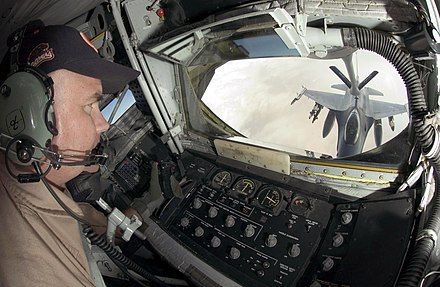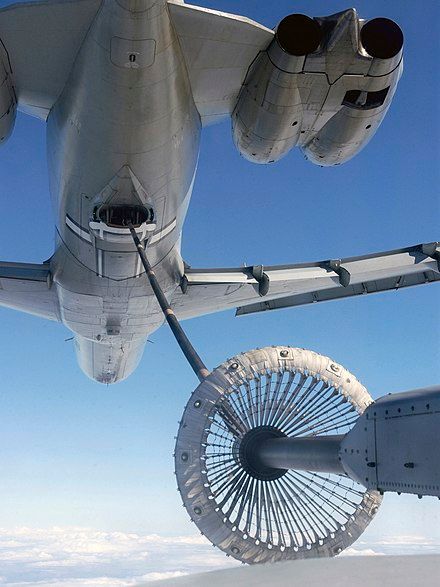Feed the (black) bird
-
Some very good flying by both pilots!!
-
Some very good flying by both pilots!!
@taiwan_girl D3 dated a guy who was in the Air Force. He was part of the re-fueling crew on a KC-135. He was the guy flying the refueling arm. It's quite the dance that occurs - three dancers: the KC-135, the plane being refueled, and the refueling boom.

The flying boom is attached to the rear of the tanker aircraft. The attachment is gimballed, allowing the boom to move with the receiver aircraft. The boom contains a rigid pipe to transfer fuel. The fuel pipe ends in a nozzle with a flexible ball joint. The nozzle mates to the "receptacle" in the receiver aircraft during fuel transfer. A poppet valve in the end of the nozzle prevents fuel from exiting the tube until the nozzle properly mates with the receiver's refueling receptacle. Once properly mated, toggles in the receptacle engage the nozzle, holding it locked during fuel transfer.
The "flying" boom is so named because flight control surfaces, small movable airfoils that are often in a V-tail configuration, are used to move the boom by creating aerodynamic forces. They are actuated hydraulically and controlled by the boom operator using a control stick. The boom operator also telescopes the boom to make the connection with the receiver's receptacle.
Interestingly, the Navy uses a "probe and drogue" approach to mid-air refueling. There is nobody "flying" the drogue.

-
Have a friend that hated when they had a Blackbird on the tarmac...Thing leaked fuel everywhere...
@Jolly said in Feed the (black) bird:
Have a friend that hated when they had a Blackbird on the tarmac...Thing leaked fuel everywhere...
No choice. They had to allow for the fuselage panels to expand due to the incredible heat generated while flying at Mach 3 at that altitude. And the jet fuel ate through any type of bladder they could devise in those days. Interestingly, it didn’t leak in the air as the panels expanded, just on the ground….
-
@Jolly said in Feed the (black) bird:
Have a friend that hated when they had a Blackbird on the tarmac...Thing leaked fuel everywhere...
No choice. They had to allow for the fuselage panels to expand due to the incredible heat generated while flying at Mach 3 at that altitude. And the jet fuel ate through any type of bladder they could devise in those days. Interestingly, it didn’t leak in the air as the panels expanded, just on the ground….
@LuFins-Dad I may be wrong, but I sort of remember reading that the SR-71 was fueled with only enough gas to get up into the air. Then, mid-air fueling topped off the tanks for the actual mission.
ETA:
On a typical SR-71 mission, the airplane took off with only a partial fuel load to reduce stress on the brakes and tires during takeoff and also ensure it could successfully take off should one engine fail. It's a common misconception that the planes refueled shortly after takeoff because the jet fuel leaked. The leaking of fuel was an intentional design feature because the high heat generated by the aircraft made it impossible to fully seal the fuselage tanks against leaks. However, the amount of fuel leaked was not enough to make the refueling necessary; the planes refueled because the maximum speeds of the aircraft were only possible with aerial refueling.
The SR-71 also required in-flight refueling to replenish fuel during long-duration missions. Supersonic flights generally lasted no more than 90 minutes before the pilot had to find a tanker.
-
@taiwan_girl D3 dated a guy who was in the Air Force. He was part of the re-fueling crew on a KC-135. He was the guy flying the refueling arm. It's quite the dance that occurs - three dancers: the KC-135, the plane being refueled, and the refueling boom.

The flying boom is attached to the rear of the tanker aircraft. The attachment is gimballed, allowing the boom to move with the receiver aircraft. The boom contains a rigid pipe to transfer fuel. The fuel pipe ends in a nozzle with a flexible ball joint. The nozzle mates to the "receptacle" in the receiver aircraft during fuel transfer. A poppet valve in the end of the nozzle prevents fuel from exiting the tube until the nozzle properly mates with the receiver's refueling receptacle. Once properly mated, toggles in the receptacle engage the nozzle, holding it locked during fuel transfer.
The "flying" boom is so named because flight control surfaces, small movable airfoils that are often in a V-tail configuration, are used to move the boom by creating aerodynamic forces. They are actuated hydraulically and controlled by the boom operator using a control stick. The boom operator also telescopes the boom to make the connection with the receiver's receptacle.
Interestingly, the Navy uses a "probe and drogue" approach to mid-air refueling. There is nobody "flying" the drogue.

@George-K said in Feed the (black) bird:
a KC-135
An FAA guy I worked with, Chris, was a pilot of a KC-135, which is a converted Boeing 707.
He had a friend who was also a 707 pilot that flew with John Travolta on his 707.
Chris was invited to fly the 707 with Travolta. Did I already tell you about how Travolta offered Chris a $5K watch in exchange for forbidden favors? Chris declined the offer.
He stopped flying with Travolta when Travolta came within seconds of destroying the plane while singing a song about a dead pilot. The way Chris tells it, he actually prevented the crash, from the jump seat behind the pilot, by pushing the throttle with his right foot.